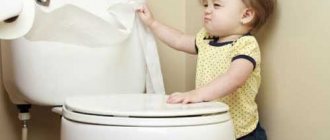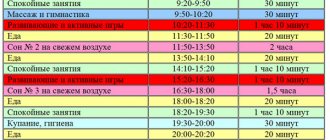Presence of a foreign object in the nose
Parents' worst nightmare is a foreign body in the child's nose.
It could be anything: a bead/lollipop/button/small part of a toy.
A big plus if:
1. The child already has speech and can tell you about the existing problem.
2. You or one of the adults saw what happened.
And if not? Then there are certain signs that will help you suspect whether there is something extra in the nose:
1. Unreasonable difficulty breathing through the nose.
2. There is discharge from the nose, although there are no cold symptoms.
3. Pain in the nose and the presence of blood.
4. Strange, unpleasant smell from the nose.
A foreign object in the nose is more likely if all of the above symptoms appear in only one nostril. If shortly before this the child came into contact with small objects, then this is even more suspicious.
What to do in such cases?
1. Self-indulgence in this situation can be very dangerous. Attempts to remove foreign objects from the child’s nose are likely to aggravate the situation: there is a risk of pushing the object even further.
2. A visit to an otorhinolaryngologist (ENT) is needed. As fast as possible.
3. Do not allow your child to play active games that require running/jumping/tumbling.
4. Assess what kind of object is in the baby’s nose. If it is one of many of the same (a bead, a piece of candy, etc.), then keep in mind that there is a high probability that further on in the respiratory tract there may be objects from the same series.
If a child starts coughing for no apparent reason, has difficulty breathing, and there is no expected improvement in the treatment of croup, pneumonia, asthma, then you need to be prepared for the fact that a foreign body has entered the bronchi or trachea.
The most dangerous age is from one to three years.
If there are breathing problems, then this is an obvious reason to go to the hospital to examine the baby’s respiratory tract. Radiography is the initial and main study for diagnosing the respiratory tract. To reliably detect a foreign object, x-rays must be taken during inhalation and exhalation.
Wheezing, an attack with bluish skin, coughing for no reason, shortness of breath - these are signs that should make a parent suspect the presence of a foreign object in the child’s respiratory tract.
In the absence of these signs and an x-ray that shows no problem, it is necessary to ensure high-quality monitoring of the baby at home.
If the attack persists or the child’s well-being worsens, you should immediately call an ambulance.
Using tweezers, the doctor will be able to remove a foreign body that is not located deeply. Using a bronchoscope, the doctor can remove a foreign body that has fallen deeper.
How to distinguish a normal runny nose from the presence of a foreign body in the nose?
If a child puts an object in his nose, some signs will help you understand that it is not a runny nose.
Signs of difference between a runny nose and a foreign body in the nasal cavity:
- If there is a foreign body, the process is usually one-sided, that is, it will itch and flow from only one nostril. With a runny nose, these signs are bilateral.
- Sudden onset. All signs appear suddenly against the background of the child’s complete health. If it is a runny nose, then children usually complain of feeling unwell (headache, drowsiness, body temperature rises).
If you think about the presence of a foreign body, but are not sure about it, be sure to show your child to the doctor. An extra examination will not harm the baby, but will help to avoid complications if there is a foreign body.
Chronic foreign bodies are clinically similar to chronic rhinitis or sinusitis (inflammation of the paranasal sinuses).
The child is worried about:
- difficulty breathing through the nose on one side;
- purulent or purulent-purulent (streaked with blood) nasal discharge with an unpleasant odor;
- inflammation of the nasal mucosa with the formation of purulent crusts.
Rhinolith is formed as a result of the long presence of a foreign body, due to which limited inflammation of the mucous membrane occurs, characterized by the proliferation of connective tissue and the deposition of salts, which ultimately ends with the foreign body becoming overgrown with the mucous membrane.
Children at this stage usually complain that they have difficulty breathing through their nose. Rhinoliths are often discovered by chance during routine examinations.
Classification of foreign bodies in a child’s nose
Why does a child have dry skin - reasons for how to moisturize
Objects that the baby managed to insert into the nasal canal are called foreign objects. The following groups of foreign bodies are distinguished, which more often end up in the child’s nostril:
- Inorganic products - buttons, beads, toy parts, paper, film. Typically, children like to push objects into the nostril on their own; less often, there is a possibility of penetration of bodies during a medical or hygienic procedure (cotton from an ear stick).
- Organic items - sunflower seed, pea, grass, foliage, pieces of food.
- Living organisms – mosquito, midge, beetle, helminth. They get caught on their own while walking, at home.
- Metal products - coins, bolts, parts of construction sets, nails. They are usually inserted in a manner similar to inorganic objects.
Important! Most often, children aged 3-7 years come to otolaryngologists with complaints of a foreign body in the nose.
Blockage of the nose by a foreign body
A child, while playing or lost in thought, may put a small object in his nose. If a baby chokes on food, a piece of food ends up in the nasal cavity. The reason for the penetration of large fractions of food (seeds, crumbs) is vomiting. When you urge, some of the vomit flows into the nasal canal, and individual pieces get stuck.
Symptoms
Symptoms of a foreign body in children's nasal passages are similar to signs of acute rhinitis (runny nose):
- Difficulty breathing through the nose;
- Nosebleeds caused by damage to the nasal mucosa;
- Pain and itching in the nose;
- Attacks of frequent sneezing;
- Strong watery discharge from the nostrils.
Signs of the presence of acute foreign bodies in the nose are similar to the picture of acute rhinitis (runny nose).
Children are often afraid of punishment for their actions, and therefore do not immediately tell their parents about what happened. Therefore, adults need to promptly detect and remove the foreign object so that the child does not injure himself.
Types of foreign objects
According to statistics, ambulances receive approximately three calls a day related to the fact that a child has stuck a foreign object up his nose. Providing first aid when various types of foreign objects get into the nose.
Ascorbinka
If a child puts a vitamin in his nose, you should not immediately try to pull it out, since it most often dissolves and comes out of the nose on its own with mucous secretions. When the ascorbic acid is large, you need to pinch the unclogged nostril and exhale forcefully through the clogged one. It is important to warn him that inhalations are through the mouth and not the nose, otherwise it may aggravate the situation (it will get into the respiratory tract).
Tablet
If a child puts a tablet in his nose, the same manipulations should be carried out as with ascorbic acid. If you get into contact with a tablet intended for use by adults, you should immediately call an ambulance to avoid poisoning the child with potent drugs.
small toy
Most often, small toys, for example, Lego parts or wheels from cars, get into children's nasal passages. Without qualified assistance, it is practically impossible to remove such a small object.
Pieces of fruit, food
I often get fruit pits, nuts, peanuts, chewing gum, and candy into children’s noses. Food tends to decompose, so it is necessary to carry out rinsing with the help of medical personnel. Parents must control their children’s diet and make it as safe as possible.
Plasticine
If a child puts plasticine in his nose, then it is necessary to consult an otolaryngologist. Plasticine becomes soft in a warm place and if you try to remove it yourself, all the mucous membranes of the nose will be covered with it. Due to the chemical composition of plasticine, allergy medications should be given as a preventive measure.
Bean, pea, bead
If small round products get into the nose, follow the same steps as with tablets. Parents often catch babies stuffing beads into their nasal passages. You should make sure that there is one bead in the nose and not a large number. When a child puts beans or other small round objects (buttons) up his nose, it is necessary to seek medical help.
Objects of natural origin are especially dangerous to stick into the nose. They begin to grow quickly in a humid environment.
Seed
If a child puts a seed in his nose, there is no need to panic, as it does not interfere with breathing in any way. But you should not let your child pull out foreign bodies on his own, otherwise he may push them even deeper. You can blow out the seed by inhaling air through your nose, or consult a doctor.
piece of paper
In cases where a child has inserted a piece of paper into his nose, he should carefully pull it out with tweezers, while he must stand still so as not to injure the mucous membrane of the nasal passages. If your baby inhales, the paper may get into his throat and he will be able to clear his throat on his own. But doctors recommend avoiding such situations (the paper may get stuck even deeper), it is better if the child, on the contrary, exhales through the nose.
cotton wool
During hygiene procedures, parents use cotton wool to clean children's nasal passages, and then cannot remove it. If you cannot get the cotton wool out with tweezers without damaging the nasal mucosa, then you should use the method of blowing out a foreign object. To prevent a piece of cotton from going deeper into the nasal passage, children should not be allowed to scratch their nose. If all manipulations do not lead to results, you should consult a doctor.
Battery
If a child puts a battery in his nose, he should immediately seek qualified medical help. The battery can cause a chemical burn to the nasal mucosa, as well as melt the cartilage in the nasal septum.
Coin
If a coin gets into the nasal passage, it is necessary to take into account that it is a hard and insoluble object that can worsen the breathing process by standing across the nasopharynx. A coin can completely block the airway (asphyxia) if it enters the trachea. In such a situation, you need to call an ambulance as quickly as possible.
What can you do at home?
The child falls asleep while breastfeeding - what to do?
To provide emergency assistance to your baby, you must do the following:
- Determine the place of penetration of a bead, cotton wool, crumbs or paper.
- Apply baby drops (“Sanorin” or “Rinonorm”) to the nasal canal.
- Press the free nostril with your finger and blow sharply into the baby’s mouth.
- Invite the child to blow his nose or make him sneeze. The reflex will be triggered by inhaling ground pepper or tickling the nose with a feather.
- Clean your nostrils with clean water from a rubber bulb (without a plastic tip).
If a child has stuck a bead too deeply into his nose, the emergency doctor will tell you what to do.
Preventive actions
Following the rules of food consumption and carefully monitoring the actions of young children will help prevent foreign objects from getting into the nose. Objects in the baby's field of vision pose a potential threat to the body. Small toys, stones, sticks, bones, seeds and tablets - the list is as wide as a child’s imagination.
Correctly selected toys
For prevention purposes, it is forbidden to leave the baby at home unattended. Toys should be purchased according to the recommended age group. You should not unnecessarily take out small household items, food products, stationery, and tableware from the closet. Do not be distracted from communicating with your baby while walking.
The possibility of a foreign object getting into a child’s nose cannot be ruled out even in families that carefully monitor whether the baby is sticking small items into the ENT organs. If adults turn away for a minute, the child will quietly hide the bead in his nose or choke on a lump of food. At the slightest suspicion of a problem, you should seek help from an otolaryngologist.
Signs that there is “foreign” in the nose
If you notice that your baby’s breathing is difficult, and only on one side, the child rubs his nose and complains of pain, start worrying.
There are other signs: clear mucus begins to secrete from a blocked nostril, becoming cloudy over time and acquiring a putrid odor. In some cases, even bleeding is observed.
If you suspect that a foreign body has entered your child’s nose, you should take immediate action. After all, the complications of this seemingly frivolous problem are quite unpleasant.
Hypoxia may develop because the supply of oxygen to the brain decreases. A foreign object can move deeper into the nasopharynx, and from there into the food or respiratory tract. Organic bodies (insects, food) begin to rot and cause inflammation. Ulceration of the mucous membrane, tissue necrosis, suppuration, the appearance of polyps - all these are possible complications when something gets stuck in the nose.
We urgently need to act.










